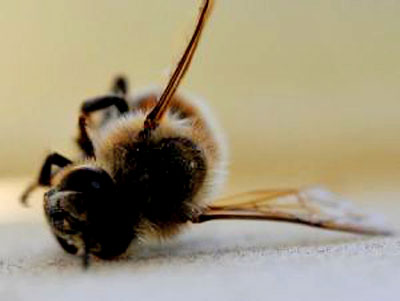|
from MotherJones Website
It's springtime, and farmers throughout the Midwest and South are preparing to plant corn - and lots of it.
The USDA projects this year's corn crop will cover 94 million acres, the most in 68 years. (By comparison, the state of California occupies a land mass of about 101 million acres.)
Nearly all of that immense stand of corn will be planted with seeds treated with neonicotinoid pesticides produced by the German chemical giant Bayer.
And that may be very bad news for honey bees, which remain in a dire state of health, riddled by large annual die-offs that have become known as "colony collapse disorder" (CCD).
In the past months, three separate studies - two of them just out in the prestigious journal Science - have added to a substantial body of literature linking widespread use of neonicotinoids to CCD.
The latest research will renew pressure on the EPA to reconsider its registration of Bayer's products. The EPA green-lighted Bayer's products based largely on a study funded by the chemical giant itself - which was later discredited by the EPA's own scientists, as this leaked memo shows.
When seeds are treated with neonics, the pesticides get absorbed by the plant's vascular system and then "expressed" in the pollen and nectar, where they attack the nervous systems of insects. Bayer targeted its treatments at the most prolific US crop - corn - and since the late 1990s, corn farmers have been blanketing millions of acres of farmland with neonic-treated seeds.
And it's not just corn. In addition to the vast corn crop mentioned above, Bayer's neonics have worked their way into substantial portions of the soy, wheat, cotton, sorghum, and peanut seed markets.
In 2010, according to research by the Pesticide Action Network of North America, at least 142 million total acres were planted in neonic-treated seeds - a trend that will continue if not increase in the 2012 growing season. That represents a landmass equal to the footprints of California and Washington State.
But even that's not all. As I showed in this January post, Bayer's neonics are also common in home-garden and landscaping products.
The ubiquitous pesticides appear to affect bees in two ways: in big lethal doses that occur at the time of seed planting, when neonic-infused dust wafts around in growing areas; and in tiny doses that happen when bees bring neonic-infused pollen into hives, which don't kill them immediately but appears to damage their immune systems and homing abilities.
Here's a quick snapshot of the new research.
The latest burst of research follows on the heels of a study released in January (Multiple Routes of Pesticide Exposure for Honey Bees Living Near Agricultural Fields) by Purdue researchers (I summarized their results in 'Are Pesticides Behind Massive Bee Die-Offs?').
They determined that bees are exposed to "extremely high" levels of Bayer's clothianidin in the fumes that rise up when farmers plant corn seed in the spring.
They found the pesticide in dead bees,
These studies, combined with what we know of the the tortured, Bayer-influenced nature of neonics' march through the regulatory process, paint a damning picture.
As Pesticide Action Network's Heather Pilatic put it on Huffington Post,
This accumulation of disturbing science raises a vital question:
The long-term status of the United States as a healthy habitat for bees, wild and cultivated alike, may hinge on the answer.
|

